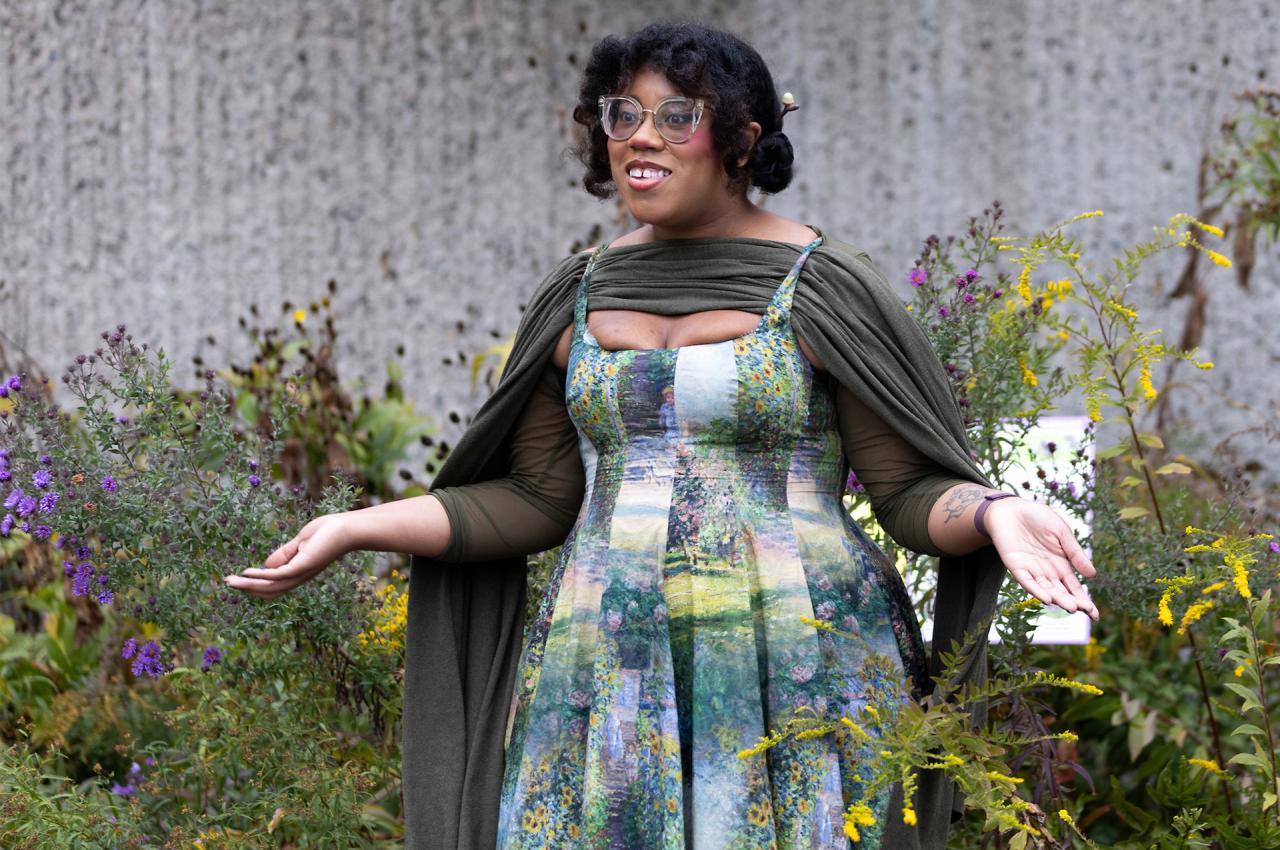The Menus Have Changed, but Dining Halls Keep Dishing Up Tastes of Home
In the fall of 1946, Stratton Hall hosted an afternoon Halloween dance. On the menu: cider, tea, finger sandwiches, and donuts. Ed Vianney, E47, asked Audrey Svensk, J49, to dance. That night, Audrey wrote one word in her diary: “Ed.” A few days later, a friend gave her a photo from the party: Ed, his face partially hidden in a cup of cider.
Soon, they were going on dates at the Kursaal, a café in the basement of Curtis Hall, which had been retrofitted after serving as a barracks in World War II. They married right after Audrey graduated. “We were married and in love for 74 years, until Ed passed away at age 97 in 2023,” Audrey said. “Stratton Hall’s dining room, where the tea dance was held, brought Ed and me together, forever.”
Through the decades, Tufts dining halls have helped forge not only true love but lifelong friendships. Grab some mac and cheese and settle in for a time-traveler's ride through the many ways that food has created delectable memories on the Hill.
Viewed through a window, Jackson College students eat in Hodgdon Hall in 1954, the year it was built as a Jackson dorm and dining space. The building was converted into a coed dining hall and dorm in 1999. Photo: Courtesy of Tufts Archival Research Center
Tablecloths and China
What Audrey Vianney, now 97, remembers about dining at Stratton is a lot different from what students today experience. “Miss Haas, the housemother, had strict rules: no curlers, pajamas, or bathrobes, and to ensure proper table manners, she would rotate from one table to another.” Audrey earned $30 a month as a waitress. “The perk was that I could eat plenty before the residents arrived! Saturday dinner was always hot dogs, baked beans, and brown bread—a Boston tradition,” she said.
Her Stratton dormmate Laura Chodos, J48, AG49, skipped breakfast and bought chocolate-covered ice cream bars to eat before her 8 a.m. classes. She worked as a waitress at The Fletcher School’s dining hall and loved the food's international flair.
“Students came from all parts of the world and would listen with rapt attention to fellow student [and future politician] Daniel Patrick Moynihan, who waved his spoon in the air and used his loud voice for emphasis. His ideas on inequality and poverty changed the direction of my life," said Chodos, who earned a graduate degree in sociology and in 1979 visited the office of New York Sen. Moynihan, A48, F49, FG61, H68, in Washington, D.C., to lobby for increased funding for public libraries.
Tufts students eat in Carmichael Hall in 1954, the year it was built as a men’s dormitory and dining hall. Photo: Courtesy of Tufts Archival Research Center
When Tufts was founded in 1852, the first dining hall was in Ballou Hall, and salted cod was a mainstay on the menu, according to Brown and Blue and Greek by Charles Trantanella, E89. When a handful of dorms were built in the second half of the 19th century, in-dorm dining rooms featured white tablecloths and bone china. Despite that touch of elegance, “[p]roviding boarding facilities satisfactory to both the students and the College proved to be a chronic problem,” according to Light on the Hill by the late Russell Miller, a professor of history and university archivist.
In 1870, a student-run boarding club, the Adams Club, opened but faltered within a decade. Curtis Hall was constructed in 1894, and the university leased part of the building to private individuals to provide boarding services.
In an attempt to have Tufts students “dine in common” and lure male students away from eating at their fraternities, The Commons (previously located in East Hall and nicknamed “The Dive”) opened at Curtis in 1903, serving breakfast, a multicourse midday dinner, and supper. A story in the September 28, 1905, Tufts Weekly signaled the end of dining in fraternities: “Books containing twenty meal tickets are sold for four dollars, and are good to use for ten days.” (During World War I, Curtis served as a mess hall for the Student Army Training Corps stationed at Tufts. During World War II, it was a Navy mess hall.)
Enterprising students and locals touted their own offerings. A man named Elmer Page managed a hotdog and snack shack called a “dog cart” around 1914, “the uncleanliness of which would not be tolerated by any respectable board of health,” reported Tufts Weekly that year. John C. “Jack” Moody, A30, helped pay his tuition by selling sandwiches and ice cream around campus.
The dining halls eventually shifted to cafeteria-style service, with students forming single-file lines, holding trays, and choosing from a few entrees and sides. On a Tuesday in the fall of 1977, the menu printed in a student newspaper listed the options for dinner as a hot turkey sandwich or “Italian spaghetti,” a far cry from the variety in today’s open buffets.
Forging Connections
Food is the seedbed of memories at Tufts.
“Food brings people together, creating connections and community,” said Lukas Dow, A12, the chef and co-founder of Judy’s Bay, an izakaya (Japanese-style bar-restaurant) in Cambridge, Massachusetts. He was active in Tufts’ Asian American Center, where he recalls events “always had food to entice students to attend. Without food, the community would not have flourished in the way it did.”
Carl Onobugu, A09, AG13, an entrepreneur and former program manager at the Tufts Africana Center, found community with friends who ate together at Dewick, starting their first semester on campus.
“There was a certain level of comfort in seeing people in a new space that resembled folks in your community back home—students who were on the staff of Onyx [a literary magazine affiliated with the Africana Center] or in the gospel choir,” he said. “We had a gravitational pull.”
Diane Bessette, J85, E19P, who grew up as an “Air Force brat,” moving all over the country, ate at Carmichael with her suitemates from Wren Hall and fondly remembers the once-a-semester New England seafood dinners. “These felt special—with steamed clams, swordfish, clam chowder—and even a little exotic for me, because I wasn’t from New England.”
Most other alumni might not remember specific items from the dining halls’ menus, but Ken Lefkowitz, A80, does.
In his first year at Tufts, he fell hard for the chocolate donuts at Carmichael, but was crushed to discover that they ran out quickly. “If you didn't get there by 8 a.m., you'd get stuck with the lemon-filled or cream-filled; totally unacceptable,” he said. He campaigned for a spot in the Tufts Community Union Senate on an “increase the number of chocolate donuts” platform. Both his campaign—and his meetings with Tufts Dining—were a success.
Lefkowitz also adored staff member Lillian Cunningham, with her sky-high beehive hairdo and bright red lipstick, who checked his meal card at the door. “She was literally like our mother. She'd say, ‘Happy breakfast!’ ‘Happy lunch!’ ‘Happy dinner!’ She was an institution.”
Lil, as she was affectionately called by students, worked at Tufts from 1974 to about 1993 and was “perhaps the most popular cashier in the history of Carmichael Dining Center,” according to a 2013 story in Tufts Magazine.
Sunday brunch at Dewick was “a big affair” for Hillary Feldman Wexler, J99, starting her first year. Her regular group, all members of the Class of ’99, included Michelle (Lapolla) Friedman, her roommate for four years and still a close friend; Cory Lankford, who wandered by her room during move-in and remarked how ugly her trashcan was; roommates Eileen Barett and Samar Shams; and Luisa Weiss, their “recruit” from Hodgdon.
“We'd stay until they kicked us out to set up for dinner,” Wexler said. “I remember leaving with my cheeks hurting from laughing so hard. Luisa and Eileen went on to be stars in the culinary world. I can't imagine it was the Dewick pancakes, but maybe?”
Luisa Weiss, a cookbook author who grew up in Berlin, remembers being overwhelmed by the dining halls at first. “At my high school, the hot lunch had been very traditional German cooking, so the breadth of what Tufts had to offer was a novelty,” she said.
The group of friends “planted the seed for my career as a chef," said Eileen Barett, a culinary instructor at City University of New York and co-founder and executive chef of Aromas Boutique Bakery. “We made room for everyone to be themselves. I learned at Tufts that food is one of the best ways to bring people together.”
Patti Klos, the senior director of Tufts Dining, has won national recognition for how she fosters innovation in the dining halls. Photo: Alonso Nichols
Comfort and Innovation
When Jennifer Brent, J94, was pregnant in 2004 with her first child, she “had a strong and sudden craving for the world's most delicious, moist banana bread that I remembered enjoying at Carmichael with my roomies.” On a whim, she emailed Tufts Dining Services. Patti Klos, the senior director of Tufts Dining, responded with a recipe for the banana bread, scaled for home use.
“I have shamelessly shared the recipe with friends and family members over the past 20 years,” Brent said. “I bake it for all kinds of occasions. Got a bad grade? Have some banana bread. Home with the flu? How ’bout some banana bread? I made one two days ago to celebrate my daughter (the one I was pregnant with when I got the recipe), who passed her driver’s test.”
“It touched my heart that Jennifer reached out for a recipe," Klos said. “I am the youngest in my generation in my family—among 16 first cousins—and the keeper of my grandmother's banana bread recipe.” The Tufts recipe is influenced by her grandmother's and that of a student who shared his grandmother's recipe with her.
Undergraduate students fuel up for finals at a special late-night breakfast in Dewick-MacPhie Dining Center in December. Photo: Jodi Hilton for Tufts University
A butternut squash bisque, developed in 1996 by John Fisher, then a unit manager for Tufts Dining, and Paul Rudolph, production chef, achieved cult status. “We created the hashtag #bisquealert, and the Tufts community would come,” Klos said. In 2018, WGBH published the recipe online, with a Q&A with Fisher, who said they were making 1,500 gallons a year.
The squash for the bisque at that time came from Czajkowski Farms in Hadley, Massachusetts. Sourcing from local farms has been a priority since the 1990s, said Klos, who received the National Association of College & University Food Services Theodore W. Minah Distinguished Service Award in 2024 and has been fostering innovation in the dining halls at Tufts for more than 35 years.
She considers the dining halls to be an extension of the learning experience students have in the classroom. “We're going to push you up against your learning edge, through food,” she said. For example, this spring, pop-up specials for “underloved fish” will debut, introducing students to fish from New England waters that aren't salmon, cod, or haddock.
But, thanks to Yves Henry, an assistant sous chef who has worked at Tufts for 50 years, innovation never kicks tradition to the side, Klos said. “Even as we were introducing new things like made-to-order stir fry in the early ’90s, he was a champion for the things that made students always feel at home. He reminded us to keep the comfort food staples—the really good mac and cheese, the grilled cheese and tomato soup, the hearty beef stew."
The university also now serves kosher, halal, allergen-free, vegetarian, and vegan meals—as well as special offerings such as late-night snacks in Dewick and Carmichael during finals. Outside the dining halls, Tufts Hillel—which opened in 1994—serves Friday night Shabbat dinners, and special-interest houses such as the Crafts House give students opportunities to cook and share meals together.
What's next? Well, if Audrey Vianney and Laura Chodos, the Jackson graduates who remember Tufts in the 1940s, were to come to campus this spring, they might see a robot server at Kindlevan Café in the Tsungming Tu Complex. Matthias Scheutz, a professor of cognitive and computer science and director of the Human-Robot Interaction Lab, is planning a pilot project in which customers use an app to direct a robot to bring food from the counter to their table. Now, can we see the dessert menu?
Thanks to Alexandra Bush and Sally Johnson of the Tufts Archival Research Center for their help with research for this article.
Latest Tufts Now
- $4 Million Gift to Advance Women’s HealthTufts Board Chair Jeff Moslow and Linda Moslow fund initiative uniting medicine and nutrition, with focus on menopause and longevity
- Study Identifies Which Patients Benefit Most From New Schizophrenia DrugBy tracking real-world responses, researcher found patterns that could help doctors match the right treatment to the right patient
- Boston Forward Sam Hauser, Delta Dental Support Program for VeteransFor every assist this season, the insurance provider will donate $25 to TUSDM Cares for Veterans
- Why Is the Cost of Owning a Home So High Now?It’s getting tougher than ever to become a homeowner, especially for first-time buyers. A Tufts economist explains why
- What Mamdani’s Victory Says About Engaging Gen Z VotersHis campaign drew a surge of new voters, including young people. Will the youth vote help shape the 2026 midterms, too?
- The ‘Black Forager’ Nibbles the CampusAlexis Nikole Nelson, an expert on foraging, shares advice for safely eating foods found in the wild













